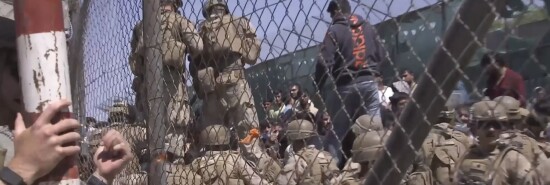
New CENTCOM interviews may shed light on the Afghanistan withdrawal
Beth Bailey
Video Embed
In November 2021, U.S. Army Central released the findings of its investigation into the U.S. withdrawal from Afghanistan based on “thousands of pages of documents” and interviews with more than 130 witnesses. Now, U.S. Central Command is updating that investigation with interviews of people who were wounded during the Aug. 26, 2021, suicide bombing that killed 13 U.S. service members and 170 Afghans at Abbey Gate in Hamid Karzai International Airport.
According to a CENTCOM press release, the interviews were conducted as a result of “new information not previously shared by any other witness” emanating from U.S. Marine Corps Sgt. Tyler Vargas-Andrews’s testimony before the House Foreign Affairs Committee in March.
COURT CHALLENGES TO KEEP TRUMP OFF 2024 ELECTION BALLOTS BEGIN IN TWO STATES
CENTCOM was not forthcoming in its press release or in response to questions from the Washington Examiner about which aspects of Vargas-Andrews’s description of events at Abbey Gate it is looking to corroborate. Vargas-Andrews’s written testimony offers multiple new points of information for CENTCOM to pursue.
First was Vargas-Andrews’s allegation that, from his sniper team’s tower, he saw a man in the crowd who “fit the description exactly” of the Islamic State suicide bomber that intelligence assets said would be in the vicinity of Abbey Gate. Though he says people from psychological operations “confirmed the subject met the suicide bomber description,” there was confusion in his chain of command as to whether Marines could engage the target.
In a shorter but no less important observation, Vargas-Andrews also said that U.S. forces “immediately … started taking fire from the neighborhood” in the aftermath of the suicide bombing. This is in direct contradiction to the previous assessment that the bombing emanated from “a single person-borne explosive device with no associated enemy small arms fire.”
CENTCOM did tell the Washington Examiner that interviewees include 16 U.S. Marines, two U.S. Army personnel, and one member of the U.S. Navy who were medically evacuated in the aftermath of the Abbey Gate bombing. Given that all of these people could not have fit in the tower from which Vargas-Andrews witnessed the suicide bomber, it is likely that CENTCOM is looking to corroborate details about the possibility that the bombing was part of a complex attack involving multiple ISIS fighters.
The Washington Examiner spoke with people who witnessed the bombing but whose insights have not been sought by CENTCOM. Their reports are based upon the specific sound and appearance of 7.62-millimeter ballistic rounds used in AK-47 rifles often wielded by Taliban or ISIS fighters compared with the appearance of and sound made by 5.56-millimeter ammunition used in American weapons.
Hospital corpsman first class Kyle Tillman told the Washington Examiner that he treated an Afghan woman during the mass casualty event who “had a 7.62 round lodged in her left forearm.”
Joe Laude, who served with the 2nd Battalion, 1st Marine Regiment in Kabul, told the Washington Examiner that he “heard rounds go off immediately after” the bombing. Laude believes “it was a case of AK-47 [fire],” adding that it “sounded like 7.62 coming in.” Laude said the incident “resembled a complex attack.”
In Laude’s role as founder of Operation Allies Refuge Foundation, an organization assisting veterans of the withdrawal in combating moral injury, he has spoken to multiple Marines about the Abbey Gate bombing. He said that several claim to have suffered wounds that they did not believe came from ball bearings within the suicide bomber’s explosive device, but from 7.62 rounds.
In response to questions about Marines’ assertions that they were wounded by 7.62 rounds, CENTCOM told the Washington Examiner that “the Armed Forces Medical Examiner’s Office found ball bearings during the autopsies of the 13 killed in action” and that “penetrative injury suffered” was “caused solely by the ball bearings.” CENTCOM stated that some of the confusion regarding impact wounds resulted from “doctors treating casualties at the hospitals at North [Hamid Karzai International Airport who] were openly describing the injuries as gunshot wounds.”
CLICK HERE TO READ MORE FROM THE WASHINGTON EXAMINER
That the search for truth and accountability regarding the withdrawal has taken so long frustrates some. Vargas-Andrews himself took to social media to express his anger that it took more than 25 months for “anyone from U.S. Army Central Command … to reach out and ask to speak to me about my experiences.”
CENTCOM’s new interviews could be an important step to clarifying one portion of the record that has been questioned by veterans of the withdrawal since it first emerged. For a fuller picture of the harrowing incidents troops saw during the final days of U.S. involvement in Afghanistan, additional investigative work remains.
Beth Bailey (@BWBailey85) is a freelance contributor to Fox News Digital and the co-host of The Afghanistan Project, which takes a deep dive into the tragedy wrought in the wake of the U.S. withdrawal from Afghanistan.
